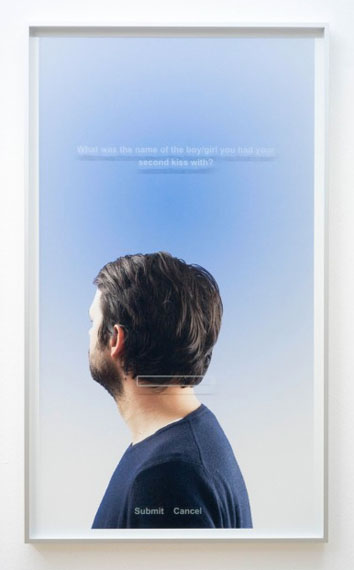
Pigment-Print, Glas graviert, gerahmt
100 x 58 cm, Auflage 4 + 1 AP
140 x 80 cm, Auflage 2 + 1 AP
Flo Maak »
COMPLETELY AUTOMATED PUBLIC TURING TEST TO TELL COMPUTERS AND HUMANS APART
Exhibition: 5 Jul – 5 Sep 2015
Sat 4 Jul 19:00
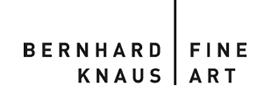
Bernhard Knaus Fine Art
Niddastr. 84
60329 Frankfurt (Main)
+49 (0)69-24450768
knaus@bernhardknaus.com
www.bernhardknaus.com
Tue-Fri 13-18, Sat 11-15 +
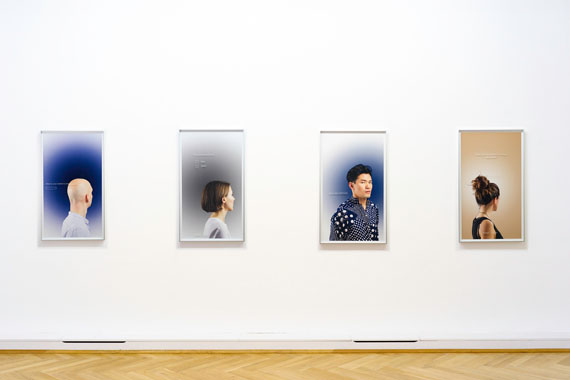
Flo Maak, "COMPLETELY AUTOMATED PUBLIC TURING TEST TO TELL COMPUTERS AND HUMANS APART"
Bernhard Knaus Fine Art
Flo Maak
"COMPLETELY AUTOMATED PUBLIC TURING TEST TO TELL COMPUTERS AND HUMANS APART"
Exhibition: 5 July – 5 September 2015
Flo Maak’s third solo exhibition in the gallery is titled "COMPLETELY AUTOMATED PUBLIC TURING TEST TO TELL COMPUTERS AND HUMANS APART".
Our perception of reality has been altered decisively by the ubiquitous presence of computers and smartphones. It seems as though it is no longer the immediate presence of a person that defines our relationships, but that person’s mediated presence on our screens. On the other hand, this presence is precarious, as the machine constantly forces us to produce evidence that we genuinely are the authorized user in question. Automatic authentication processes have therefore become a fixed part of our daily lives. They constantly mediate between ourselves and the digital world, which has become essential to our existence.
A new portrait series (2015) shows individuals standing in front of monochrome color gradients. They are facing away from the viewer. Their eyes are closed or they are staring into an undefined exterior. The images are presented in the 16:9 format currently dominating our mobile phone and television screens, something that is immediately apparent in the landscape shots.
Text and graphic elements have been engraved on the glass used to frame the photographs. These are taken from online questions used to verify user authentication. "What is the first name of the first person you kissed?" or "Who was your childhood hero?" These are questions with easily memorable answers, which should however only be known to the real profile user. In Maak’s works, these kinds of questions and the buttons, input fields and graphics connected to them make the glass visible as a transparent plane between image and viewer. The shadows these carved signs cast on the photograph behind the glass further enhance the impression of mediacy. They visually push the photograph backwards, we now perceive it as an object in space. This makes the space in the photographs, which is fairly undefined by the color gradients, even more so, and the people, most of whom have their backs turned towards us, seem even more distracted.
The groups of sculptures titled “Bodies That Matter” (2015) likewise deal with presence in space. Each of these is made up of two stacked weight plates in different sizes, stabilized by acrylic rods of different lengths vertically protruding from the center of the discs. Printed images of the standing weights are attached to the tops of the transparent tubes. With the immediate presence of the plates as stabilizing weights and the image of the same towering above these sculptures refer only to themselves. They are present in the here and now as objects and as their own image.
In the exhibition these two new work series are arranged around two of the artist’s works, “Look” and “Look (Red)” in the center.The latter determine the direction of the viewers’ gaze in the overall structure of the exhibition, their line of sight always crosses those of the other portraits somewhere in the exhibition space. As do the lines in the decision matrix printed on the back of the brochure accompanying the exhibition. This serves as the starting point to the COMPLETELY AUTOMATED PUBLIC TURING TEST TO TELL COMPUTERS AND HUMANS APART!
Flo Maak (born 1980 in Fulda), studied at Städelschule, Staatliche Hochschule für Bildende Künste under Wolfgang Tillmans and Visual Arts at Cooper Union, New York City. He also holds a degree in Art History, Philosophy and Sociology from Frankfurt’s Goethe University. He is a master student of Willem de Rooij’s. He has been a professor of Fine Art Photography at Chung-Ang University, Seoul, South Korea since 2013. Flo Maak has exhibited in numerous group and solo shows and his work is represented in renowned private and public collections. �
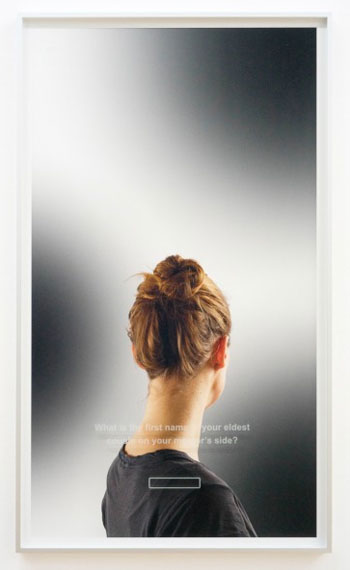
Pigment-Print, Glas graviert, gerahmt
100 x 58 cm, Auflage 4 + 1 AP
140 x 80 cm, Auflage 2 + 1 AP
Flo Maak
"COMPLETELY AUTOMATED PUBLIC TURING TEST TO TELL COMPUTERS AND HUMANS APART"
Ausstellung: 5. Juli bis 5. September 2015
Die dritte Einzelausstellung Flo Maaks in der Galerie trägt den Titel "COMPLETELY AUTOMATED PUBLIC TURING TEST TO TELL COMPUTERS AND HUMANS APART".
Unsere Wahrnehmung von Realität hat sich durch die allgegenwärtige Präsenz von Computern und Smartphones entscheidend verändert. Nicht mehr die unmittelbare Anwesenheit einer Person scheint unsere Beziehungen zu definieren, sondern deren vermittelte Präsenz in Bildern auf Bildschirmen. Allerdings ist diese Präsenz eine prekäre, weil wir uns gegenüber dem Gerät immer in Beweisnot befinden, wirklich der autorisierte Benutzer zu sein. Automatische Authentifizierungsprozesse gehören denn auch zu unserem täglichen Glück. Sie schieben sich ständig zwischen uns und die unabdingbar gewordene digitale Welt.
Eine neue Serie von Portraits (2015) zeigt vor monochromen Farbverläufen stehende Personen. Diese haben sich von uns abgewandt. Sie haben ihre Augen geschlossen oder starren in ein unbestimmtes Außen. Die Bilder werden im heute bei Handy- und Fernsehbildschirmen dominierenden, 16:9-Bildformat präsentiert, was uns vor allem beim Querformat sofort ins Auge sticht.
Auf das Glas der Rahmen sind Texte und graphische Elemente graviert, die Onlineabfragen entnommen wurden, die zur Verifizierung von Nutzern eingesetzt werden. "What is the first name of the first person you kissed?" oder "What was your childhood hero?" Es handelt sich dabei um gut erinnerbare Fragen, auf die jedoch nur der tatsächliche Nutzer des Profils die Antwort kennen sollte. In Maaks Arbeiten machen solche Fragen und damit verbundene Buttons, Eingabefelder und Grafiken das Glas als transparente Ebene zwischen Bild und Betrachter/in sichtbar. Schatten der eingeritzten Zeichen auf den dahinterliegenden Fotografien verstärken den Eindruck der Vermitteltheit. Optisch drängen sie die Fotografie als reales Objekt im Raum zurück, wodurch der durch die Farbverläufe wenig bestimmte Raum noch unbestimmter wird und die Personen, die uns meist den Rücken zuwenden, noch abwesender erscheinen.
Die Skulpturengruppen "Bodies That Matter" (2015) beschäftigen sich ebenfalls mit der Präsenz im Raum. Sie bestehen aus zwei am Boden übereinander liegenden Hantelscheiben in verschiedenen Größen, die je einen Acrylstab unterschiedlicher Höhe senkrecht stabilisieren. Oben aufgesteckt auf diesen transparenten Rohren sind ebenfalls auf transparentes Acrylglas gedruckt Abbilder der Standgewichte. Diese unmittelbare Präsenz der Hantelscheiben als stabilisierende Gewichte und als das oben thronende Abbild davon, sie verweisen nur auf sich selbst. Sie sind hier und jetzt anwesend als Objekt und Abbild ihrer selbst.
Diese zwei neuen Werkreihen gruppieren sich in der Ausstellung um ein Zentrum mit den zwei Arbeiten "Look" und "Look (Red)", die im ganzen Ausstellungsgefüge die übergreifenden Blickrichtungen vorgeben, mit denen sich die Blickachsen anderer Portaits in der Ausstellung irgendwo wieder kreuzen. Wie die Linien im Entscheidungsraster, der auf der Rückseite der zur Ausstellung erscheinen Broschüre gedruckt ist. Er dient als Ausgangspunkt des vollständig automatisierten Touring Tests um Computer von Menschen zu unterscheiden!
Flo Maak (geb. 1980 in Fulda), studierte an der Frankfurter Städelschule bei Wolfgang Tillmans und Visual Arts an der Cooper Union, New York City sowie Kunstgeschichte, Philosophie und Soziologie an der Goethe Universität Frankfurt. Er ist Meisterschüler von Willem de Rooij. Seit 2013 ist er Professor für Fine Art Photography an der Chung-Ang University, Seoul, Südkorea. Flo Maak stellte bislang in zahlreichen Gruppen - und Einzelausstellungen aus und ist in namhaften privaten und öffentlichen Sammlungen vertreten.�
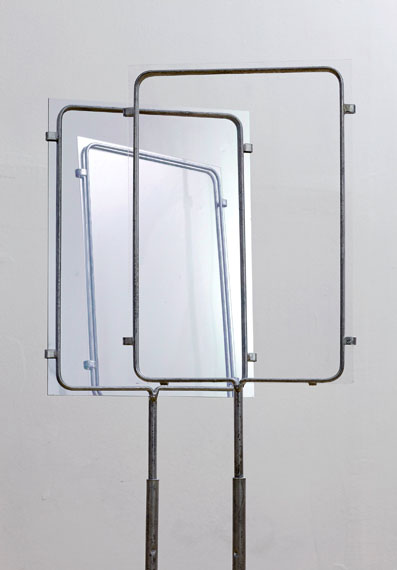
Pigment-Print, gerahmt
42 x 59,4 cm, Auflage 3 / 4 + 1 AP